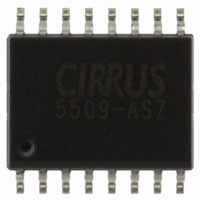CS5509-ASZ Cirrus Logic Inc, CS5509-ASZ Datasheet - Page 15

CS5509-ASZ
Manufacturer Part Number
CS5509-ASZ
Description
IC ADC 16BIT SGNL SUPP 16-SOIC
Manufacturer
Cirrus Logic Inc
Datasheet
1.CS5509-ASZ.pdf
(24 pages)
Specifications of CS5509-ASZ
Number Of Converters
1
Package / Case
16-SOIC (0.300", 7.50mm Width)
Number Of Bits
16
Sampling Rate (per Second)
200
Data Interface
Serial
Power Dissipation (max)
2.25mW
Voltage Supply Source
Analog and Digital
Operating Temperature
-40°C ~ 85°C
Mounting Type
Surface Mount
Number Of Adc Inputs
1
Architecture
Delta-Sigma
Conversion Rate
20 SPs
Resolution
16 bit
Input Type
Voltage
Interface Type
Serial
Voltage Reference
1.2 V
Supply Voltage (max)
5 V
Supply Voltage (min)
3.3 V
Maximum Power Dissipation
2.25 mW
Maximum Operating Temperature
+ 85 C
Mounting Style
SMD/SMT
Input Voltage
3.3 V to 5 V
Minimum Operating Temperature
- 40 C
Lead Free Status / RoHS Status
Lead free / RoHS Compliant
Lead Free Status / RoHS Status
Lead free / RoHS Compliant, Lead free / RoHS Compliant
Other names
598-1100-5
Available stocks
Company
Part Number
Manufacturer
Quantity
Price
Company:
Part Number:
CS5509-ASZ
Manufacturer:
CIRRUS
Quantity:
44
Part Number:
CS5509-ASZ
Manufacturer:
CIRRUS
Quantity:
20 000
to prevent aliasing. Spectral components greater
than one half the output word rate on the VREF in-
puts (VREF+ and VREF-) may also be aliased. Fil-
tering of the reference voltage to remove these
spectral components from the reference voltage is
desirable.
Crystal Oscillator
The CS5509 is designed to be operated using a
32.768kHz "tuning fork" type crystal. One end of
the crystal should be connected to the XIN input.
The other end should be attached to XOUT. Short
lead lengths should be used to minimize stray ca-
pacitance.
Over the industrial temperature range (-40 to
+85 °C) the on-chip gate oscillator will oscillate
with other crystals in the range of 30kHz to 53 kHz.
The chip will operate with external clock frequen-
cies from 30kHz to 330kHz over the industrial tem-
perature range. The 32.768 kHz crystal is normally
specified as a time-keeping crystal with tight spec-
ifications for both initial frequency and for drift
over temperature. To maintain excellent frequency
stability, these crystals are specified only over lim-
ited operating temperature ranges (i.e. -10 °C to
+60 °C) by the manufacturers. Applications of
these crystals with the CS5509 does not require
tight initial tolerance or low tempco drift. There-
fore, a lower cost crystal with looser initial toler-
ance and tempco will generally be adequate for use
with the CS5509. Also check with the manufactur-
er about wide temperature range application of
their standard crystals. Generally, even those crys-
tals specified for limited temperature range will op-
erate over much larger ranges if frequency stability
over temperature is not a requirement. The frequen-
cy stability can be as bad as ±3000 ppm over the
operating temperature range and still be typically
better than the line frequency (50 Hz or 60Hz) sta-
bility over cycle-to-cycle during the course of a
day.
DS125F3
Serial Interface Logic
The digital filter in the CS5509 takes 1624 clock
cycles to compute an output word once a conver-
sion begins. At the end of the conversion cycle, the
filter will attempt to update the serial port. Two
clock cycles prior to the update DRDY will go
high. When DRDY goes high just prior to a port up-
date it checks to see if the port is either empty or
unselected (CS = 1). If the port is empty or unse-
lected, the digital filter will update the port with a
new output word. When new data is put into the
port DRDY will go low.
Reading Serial Data
SDATA is the output pin for the serial data. When
CS goes low after new data becomes available
(DRDY goes low), the SDATA pin comes out of
Hi-Z with the MSB data bit present. SCLK is the
input pin for the serial clock. If the MSB data bit is
on the SDATA pin, the first rising edge of SCLK
enables the shifting mechanism. This allows the
falling edges of SCLK to shift subsequent data bits
out of the port. Note that if the MSB data bit is out-
put and the SCLK signal is high, the first falling
edge of SCLK will be ignored because the shifting
mechanism has not become activated. After the
first rising edge of SCLK, each subsequent falling
edge will shift out the serial data. Once the LSB is
present, the falling edge of SCLK will cause the
SDATA output to go to Hi-Z and DRDY to return
high. The serial port register will be updated with a
new data word upon the completion of another con-
version if the serial port has been emptied, or if the
CS is inactive (high).
CS can be operated asynchronously to the DRDY
signal. The DRDY signal need not be monitored as
long as the CS signal is taken low for at least two
XIN clock cycles plus 200ns prior to SCLK being
toggled. This ensures that CS has gained control
over the serial port.
CS5509
15

















